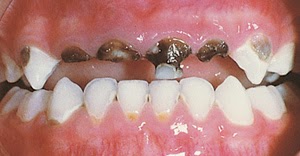Baby Bottle Mouth, also known as Baby Bottle Tooth Decay or Early Childhood Caries, is caused by the frequent and long-term exposure to your child's teeth to liquids containing sugar. Among these sugary drinks is.... milk. Yes, you heard right, milk! Many mothers do not know how to care for their child's teeth. So, let's review!
Who Gets Baby Bottle Tooth Decay?
Every child is susceptible to tooth decay. You know that clear saliva drooling from your babies mouth from time to time? This is the culprit, and the problem comes at the wonderful time your baby falls asleep. Swallowing decreases and saliva production plummets. Any liquid left in your child's mouth during sleep continues to wear down the enamel. However, bedtime is not the only time this can occur. If you allow your child to run around during the day with a bottle in their mouth, this increases the exposure times to those sugars.
What are the Symptoms of Baby Bottle Tooth Decay?
This decay strikes the most visible portion of the front teeth. This can be clearly seen if a mother is actively looking inside her child's mouth. However, the front teeth are not the only teeth affected. Any erupted tooth can be suspect to decay. This decay, if severe enough, can cause the child pain and if the decay continues further, can affect the permanent tooth sitting patiently below.
What Does the Decay Look Like?
In the beginning stages, decay may be un-noticeable. Until the enamel is completely broken down decay is hard to detect. However, it is still there. Check daily for any white, yellow or brown spots on your child's teeth. These colors indicate how severe the decay may be.
 |
| Healthy Smile |
 |
| Beginning Stages of Decay |
 |
| Mild Decay |
 |
| Moderate Decay |
 |
| Severe Decay |
How Can Baby Bottle Tooth Decay be Prevented?
Tooth decay can be prevented by reducing the exposure times to liquids containing sugar. Do not put your child to sleep with a bottle of juice or milk! Moving the feeding time forward by even 15 minutes so that your child can finish eating prior to bedtime can significantly protect the teeth. Many children are only put to sleep by the comfort of sucking. Rather than a bottle, a pacifier is a better option. A bottle of water is also a good option. If your baby is in the habit of juice at bedtime, try diluting the juice with water.
The American Academy of Pediatrics wisely recommends that parents only give bottles during feedings and not allow their children to carry a bottle between meals.
I also commend the American Academy of Pediatric Dentistry’s recommendation to start cleaning your child's teeth at least once a day as soon as the teeth come in. Allowing your child to chew or suck on a tooth brush from an early age will help in the process of brushing.
Remember, follow a dental routine! We recommend seeing your children twice a year from the age of 2, if not before. This allows us to catch early decay before extractions or root canals are needed. Start healthy habits while your children are young. If you love to brush your teeth, so will they!
-A Healthy Body Starts With a Healthy Smile-














